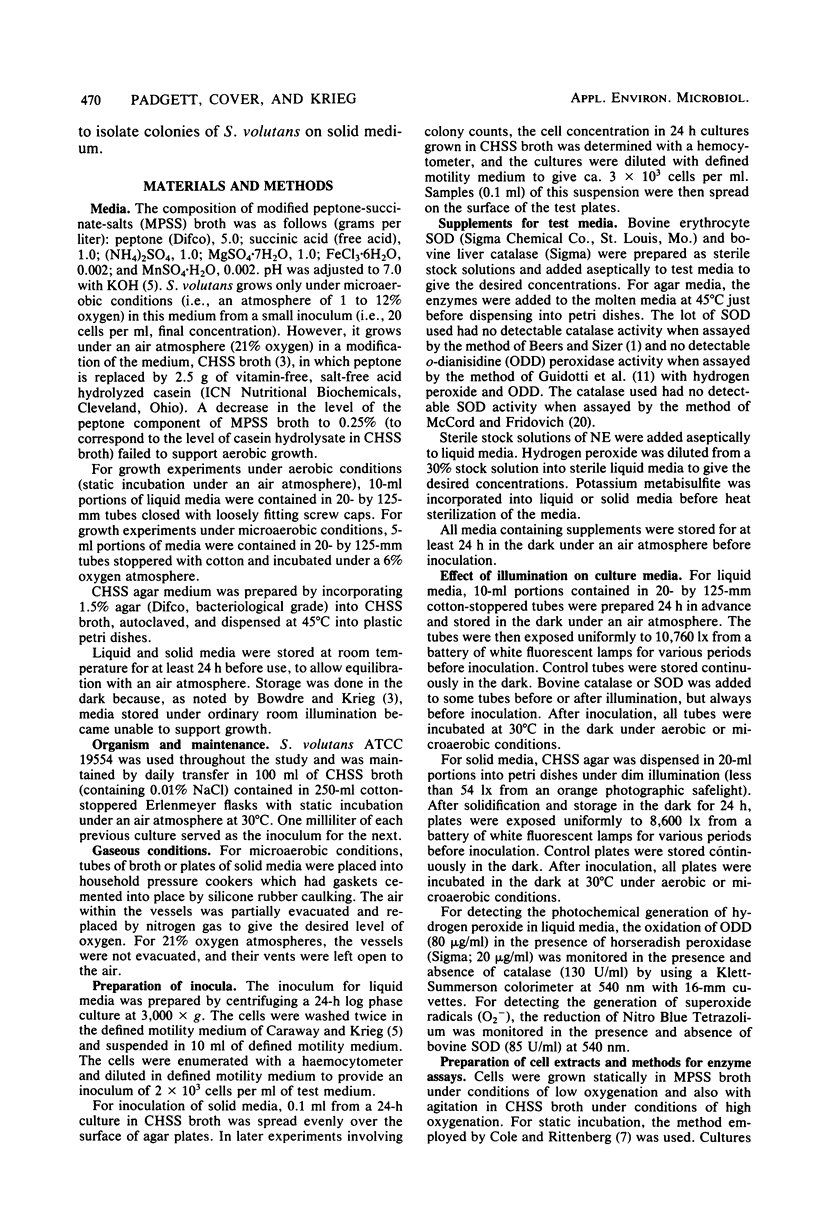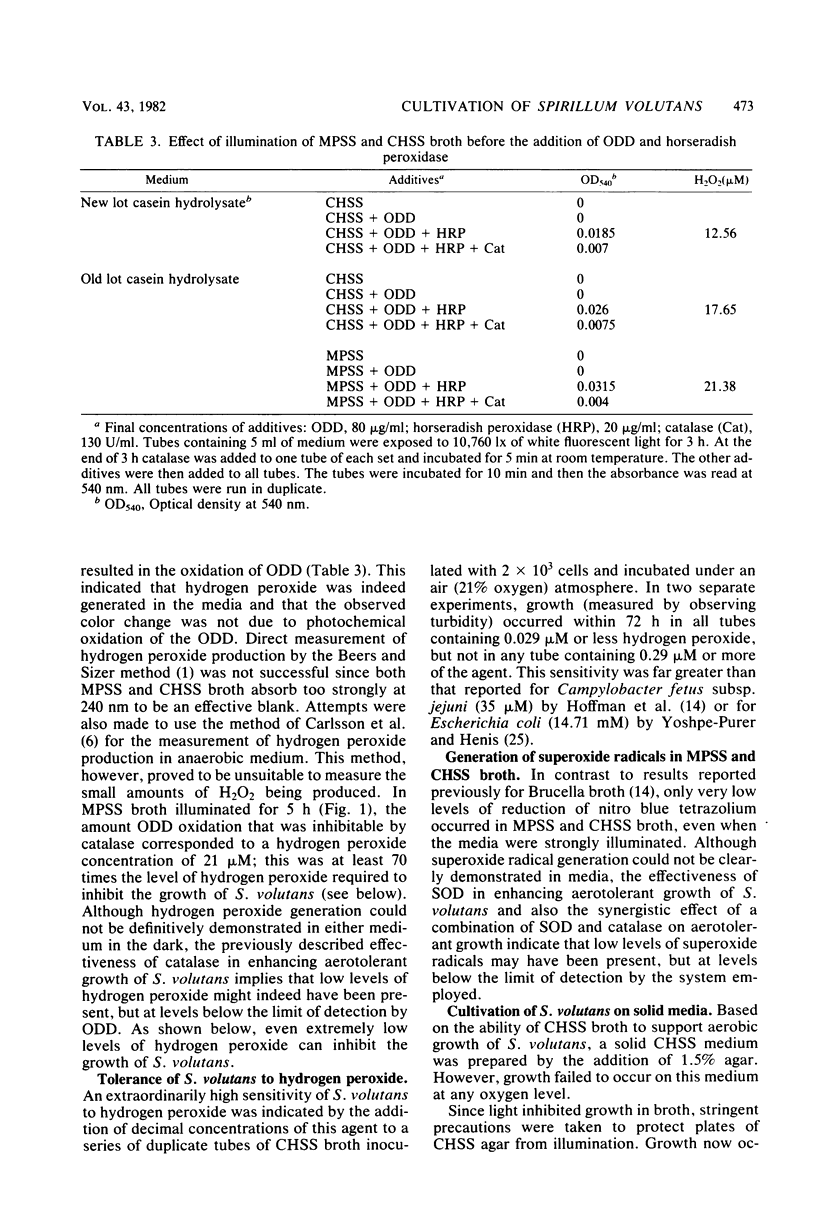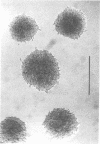Abstract
Spirillum volutans grows only under microaerobic conditions in a peptone-succinate-salts broth, but can grow aerobically when the peptone is replaced by vitamin-free acid-hydrolyzed casein broth. The addition of potassium metabisulfite, norepinephrine, catalase or superoxide dismutase (SOD) permitted aerobic growth in peptone-succinate-salts broth. A combination of catalase and SOD had a synergistic effect. S. volutans lacked catalase and had only a low level of peroxidase activity, but did possess SOD activity (12 to 14 U/mg of protein). The organism was found to be extraordinarily sensitive to exogenous hydrogen peroxide. Illumination of peptone-succinate-salts broth generated hydrogen peroxide and rendered the medium inhibitory to growth. A combination of catalase and SOD prevented this inhibition. Growth of S. volutans on solid media, not previously possible, was accomplished by the use of vitamin-free acid-hydrolyzed casein and peptone-succinate-salts agar media; maximum growth responses were dependent on the following combination of factors: addition of bisulfite, catalase, or SOD, protection of the media from illumination, incubation in a highly humid atmosphere, and incubation under atmospheres of 12% oxygen or less. The results indicate that the microaerophilic nature of S. volutans is attributable largely to the high sensitivity of the organism to exogenous hydrogen peroxide and, to a lesser extent, superoxide radicals occurring in the culture medium.
Full text
PDF








Images in this article
Selected References
These references are in PubMed. This may not be the complete list of references from this article.
- BEERS R. F., Jr, SIZER I. W. A spectrophotometric method for measuring the breakdown of hydrogen peroxide by catalase. J Biol Chem. 1952 Mar;195(1):133–140. [PubMed] [Google Scholar]
- Blakemore R. P., Maratea D., Wolfe R. S. Isolation and pure culture of a freshwater magnetic spirillum in chemically defined medium. J Bacteriol. 1979 Nov;140(2):720–729. doi: 10.1128/jb.140.2.720-729.1979. [DOI] [PMC free article] [PubMed] [Google Scholar]
- Bowdre J. H., Krieg N. R., Hoffman P. S., Smibert R. M. Stimulatory effect of dihydroxyphenyl compounds on the aerotolerance of Spirillum volutans and Campylobacter fetus subspecies jejuni. Appl Environ Microbiol. 1976 Jan;31(1):127–133. doi: 10.1128/aem.31.1.127-133.1976. [DOI] [PMC free article] [PubMed] [Google Scholar]
- Cole J. A., Rittenberg S. C. A comparison of respiratory processes in Spirillum volutans, Spirillum itersonii and Spirillum serpens. J Gen Microbiol. 1971 Dec;69(3):375–383. doi: 10.1099/00221287-69-3-375. [DOI] [PubMed] [Google Scholar]
- DOLIN M. I. The Streptococcus faecalis oxidases for reduced diphosphopyridine nucleotide. III. Isolation and properties of a flavin peroxidase for reduced diphosphopyridine nucleotide. J Biol Chem. 1957 Mar;225(1):557–573. [PubMed] [Google Scholar]
- Diguiseppi J., Fridovich I. Putative superoxide dismutase activity of iron-EDTA: a reexamination. Arch Biochem Biophys. 1980 Aug;203(1):145–150. doi: 10.1016/0003-9861(80)90162-9. [DOI] [PubMed] [Google Scholar]
- Ellfolk N., Soininen R. Pseudomonas cytochrome c peroxidase. I. Purification procedure. Acta Chem Scand. 1970;24(6):2126–2136. doi: 10.3891/acta.chem.scand.24-2126. [DOI] [PubMed] [Google Scholar]
- Halliwell B. Biochemical mechanisms accounting for the toxic action of oxygen on living organisms: the key role of superoxide dismutase. Cell Biol Int Rep. 1978 Mar;2(2):113–128. doi: 10.1016/0309-1651(78)90032-2. [DOI] [PubMed] [Google Scholar]
- Harvey S., Lascelles J. Respiratory systems and cytochromes in Campylobacter fetus subsp. intestinalis. J Bacteriol. 1980 Dec;144(3):917–922. doi: 10.1128/jb.144.3.917-922.1980. [DOI] [PMC free article] [PubMed] [Google Scholar]
- Hoffman P. S., George H. A., Krieg N. R., Smibert R. M. Studies of the microaerophilic nature of Campylobacter fetus subsp. jejuni. II. Role of exogenous superoxide anions and hydrogen peroxide. Can J Microbiol. 1979 Jan;25(1):8–16. doi: 10.1139/m79-002. [DOI] [PubMed] [Google Scholar]
- Hoffman P. S., Krieg N. R., Smibert R. M. Studies of the microaerophilic nature of Campylobacter fetus subsp. jejuni. I. Physiological aspects of enhanced aerotolerance. Can J Microbiol. 1979 Jan;25(1):1–7. doi: 10.1139/m79-001. [DOI] [PubMed] [Google Scholar]
- Hylemon P. B., Krieg N. R., Phibbs P. V., Jr Transport and catabolism of D-fructose by Spirillum itersomii. J Bacteriol. 1974 Jan;117(1):144–150. doi: 10.1128/jb.117.1.144-150.1974. [DOI] [PMC free article] [PubMed] [Google Scholar]
- Krieg N. R. Biology of the chemoheterotrophic spirilla. Bacteriol Rev. 1976 Mar;40(1):55–115. doi: 10.1128/br.40.1.55-115.1976. [DOI] [PMC free article] [PubMed] [Google Scholar]
- McCord J. M., Fridovich I. The utility of superoxide dismutase in studying free radical reactions. I. Radicals generated by the interaction of sulfite, dimethyl sulfoxide, and oxygen. J Biol Chem. 1969 Nov 25;244(22):6056–6063. [PubMed] [Google Scholar]
- RITTENBERG B. T., RITT ENBERG S. C. The growth of Spirillum volutans Ehrenberg in mixed and pure cultures. Arch Mikrobiol. 1962;42:138–153. doi: 10.1007/BF00408170. [DOI] [PubMed] [Google Scholar]
- Waterworth P. M. The action of light on culture media. J Clin Pathol. 1969 May;22(3):273–277. doi: 10.1136/jcp.22.3.273. [DOI] [PMC free article] [PubMed] [Google Scholar]
- Wells J. S., Krieg N. R. Cultivation of Spirillum volutans in a Bacteria-Free Environment. J Bacteriol. 1965 Sep;90(3):817–818. doi: 10.1128/jb.90.3.817-818.1965. [DOI] [PMC free article] [PubMed] [Google Scholar]
- Yoshpe-Purer Y., Henis Y. Factors affecting catalase level and sensitivity to hydrogen peroxide in Escherichia coli. Appl Environ Microbiol. 1976 Oct;32(4):465–469. doi: 10.1128/aem.32.4.465-469.1976. [DOI] [PMC free article] [PubMed] [Google Scholar]



